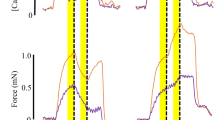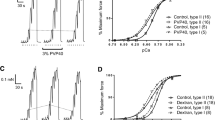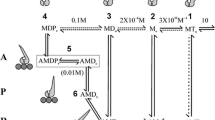Abstract
We investigated whether the inhibition of force generation observed in compressed muscle fibers is accompanied by a coupled reduction in hydrolytic activity. Isometric force and rates of ATP hydrolysis (ATPase) were measured as functions of the relative width of chemically skinned skeletal muscle fiber segments immersed in relaxing (pCa>8) and activating (pCa 4.9) salt solutions. Osmotic radial compression of the fiber segment was produced (with little or no affect on striation spacing) by adding Dextran T500 to the bathing media. ADP as a product of ATP hydrolysis in fibers undergoing 10–15 min contractions was measured using high pressure liquid chromatography. Compression of the (initially swollen) fiber segment with dextran produced a slight (4%) increase in average active force and then, with further compression, a sharp decrease (with maximum around in situ width). With compression, the average ATPase of the fiber decreased monotonically, and with extreme compression (with 0.22 g dextran per ml), ATPase fell to a fifth of its level determined in dextran-free solution while force was abolished. The time course of active force development was described by the sum of two exponential functions, the faster of which characterized the rate of rise. Fiber compression (0.14 g dextran per ml) reduced the rate of rise of force ten-fold compared to that in dextran-free solution. Hindrance of cross movement is proposed to account for the inhibition of active force generation and (coupled) ATPase in compressed fibers.
Similar content being viewed by others
References
April EW, Maughan DW (1982) Correlation between interfilament spacing and force generation in striated muscle. Biophys J 37 (2):129a
Berman MR, Maughan DW (1982) Axial elastic modulus as a function of relative fiber width in relaxed skinned skeletal muscle fibers. Pflügers Arch 393:99–103
Fabiato A, Fabiato F (1979) Calculator programs for computing the composition of the solutions containing multiple metals and ligands used for experiments in skinned muscle cells. J Physiol 75:463–505
Godt RE, Lindley BD (1982) Influence of temperature upon contractile activation and isometric force production in mechanically skinned muscle fibers of the frog. J Gen Physiol 80:279–297
Godt RE, Maughan DW (1981) Influence of osmotic compression on calcium activation and tension in skinned muscle fibers of the rabbit. Pflügers Arch 391:334–337
Huxley AF, Simmons RM (1973) Mechanical transients and the origin of muscular force. Cold Spring Harb Symp Quant Biol 37:669–680
Krasner B (1979) Nonparallel isometric tension response of rabbit soleus skinned muscle fibers to magnesium adenosine triphosphate and magnesium inosine triphosphate. J Gen Physiol 74:261–274
Krasner B, Kushmerick M (1980) Dibucaine inhibits SR ATPase and increases sensitivity of “skinned” soleus muscle fibers to calcium. Fed Proc 39:2173
Kushmerick MJ, Krasner B (1982) Force and ATPase rate in skinned skeletal muscle fibers. Fed Proc 14:2232–2237
Levy RM, Umazume Y, Kushmerick MJ (1976) Ca2+ dependence of tension and ADP production in segments of chemically skinned muscle fibers. Biochim Biophys Acta 430:352–365
Lowry OH, Rosebrough NJ, Farr AL, Randall RJ (1951) Protein measurement with the Folin phenol reagent. J Biol Chem 193: 265–275
Maughan DW (1982) Use of functionally-skinned tissue in studying altered contractility in hypertrophied myocardium. In: Alpert NR (ed) Perspectives in cardiovascular research, vol 7. Myocardial hypertrophy and failure. Raven Press, New York
Maughan DW, Godt RE (1981) Inhibition of force production in compressed skinned muscle fibers of the frog. Pflügers Arch 390:161–163
Rome E (1972) Relaxation of glycerinated muscle: Low-angle X-ray diffraction studies. J Mol Biol 65:331–345
Schoenberg M (1980) Geometrical factors influencing muscle force development. I. The effect of filament spacing upon axial forces. Biophys J 30:51–68
Stephenson EW (1981) Activation of fast skeletal muscle: Contributions of studies on skinned fibers. Am J Physiol 240 (Cell Physiol. 9):C1–19
Vink H (1971) Precision measurements of osmotic pressure in concentrated polymer solutions. Eur Polymer J 7:1411–1419
Author information
Authors and Affiliations
Rights and permissions
About this article
Cite this article
Krasner, B., Maughan, D. The relationship between ATP hydrolysis and active force in compressed and swollen skinned muscle fibers of the rabbit. Pflügers Arch. 400, 160–165 (1984). https://doi.org/10.1007/BF00585033
Received:
Accepted:
Issue Date:
DOI: https://doi.org/10.1007/BF00585033




